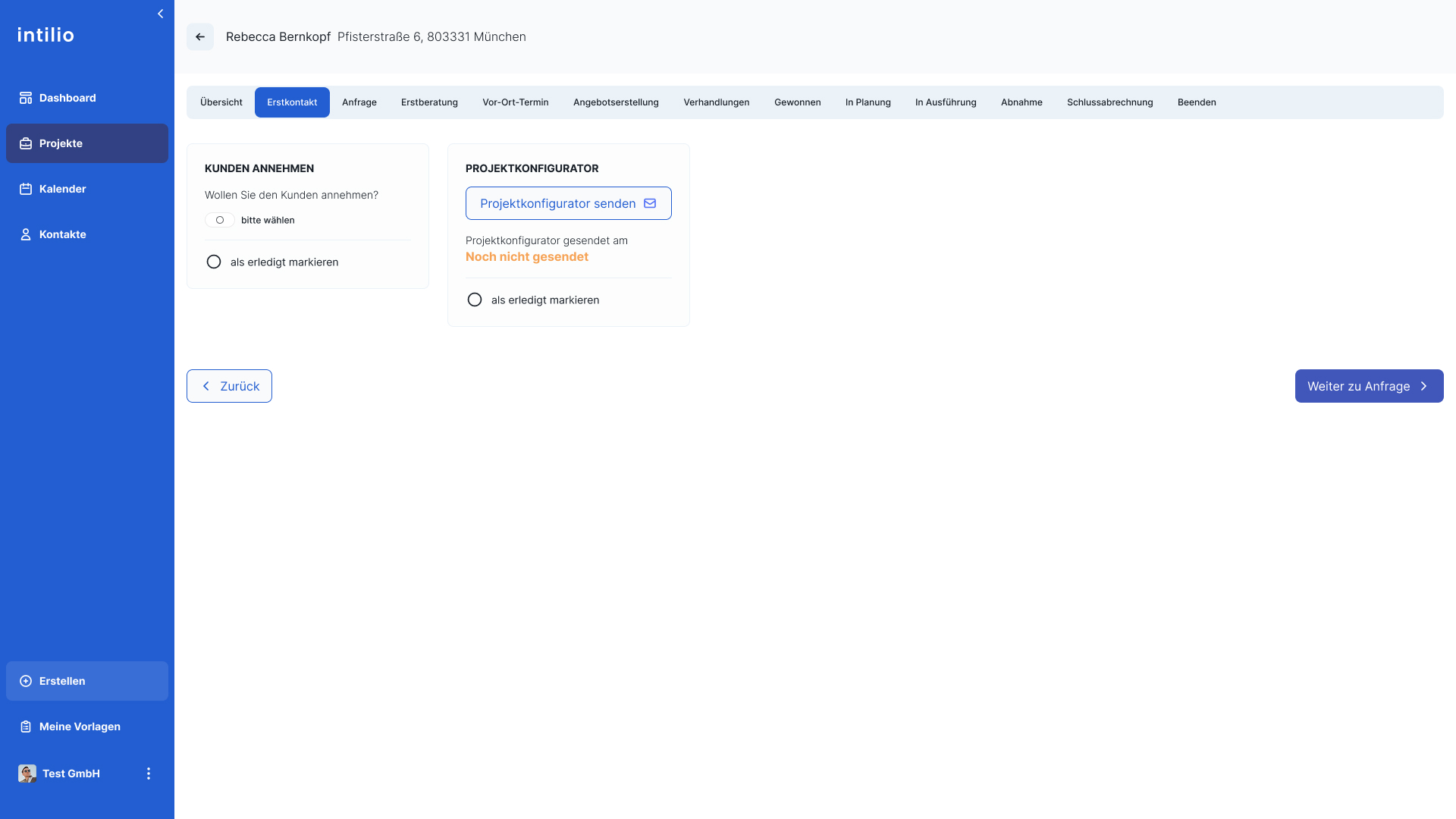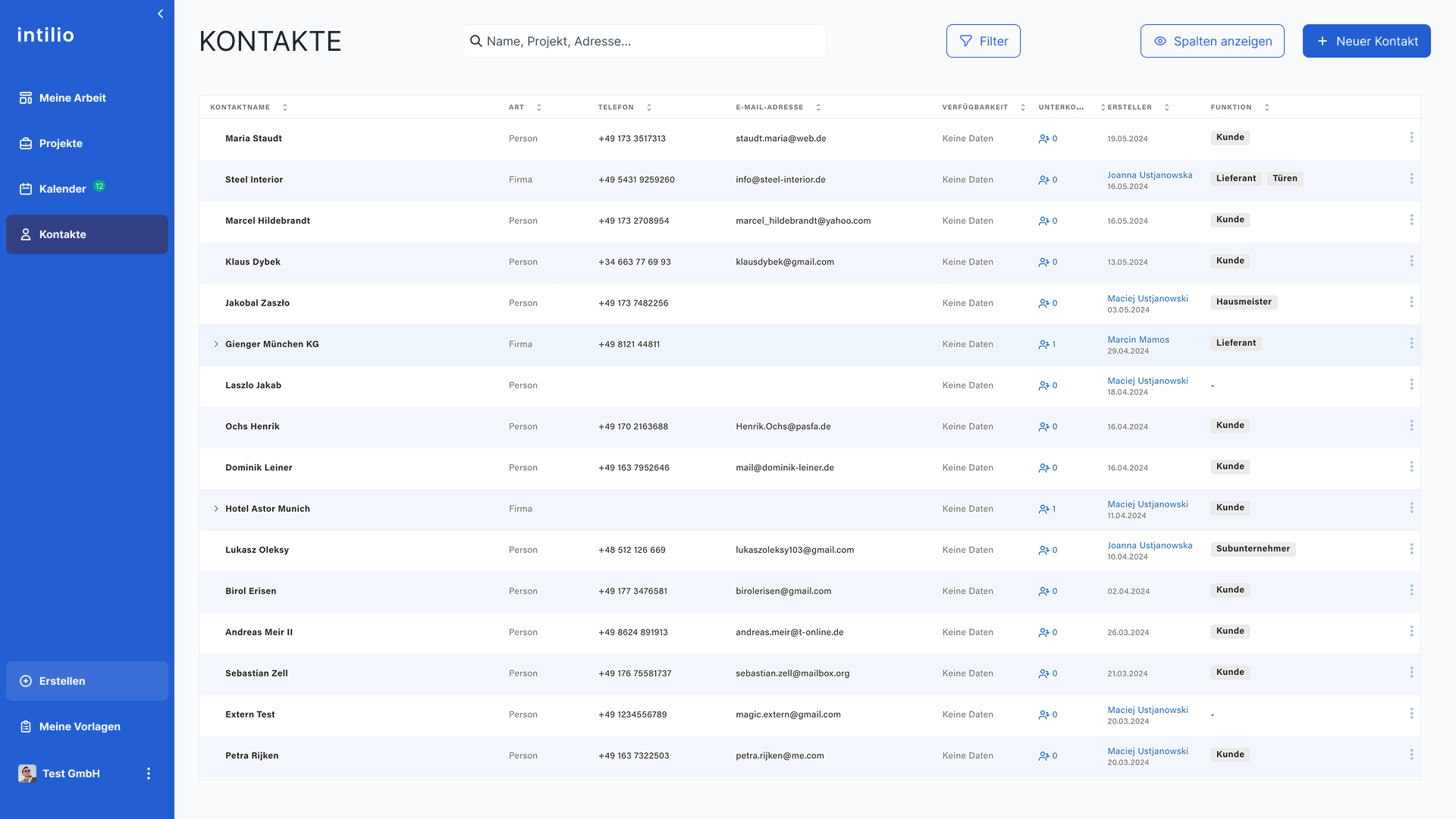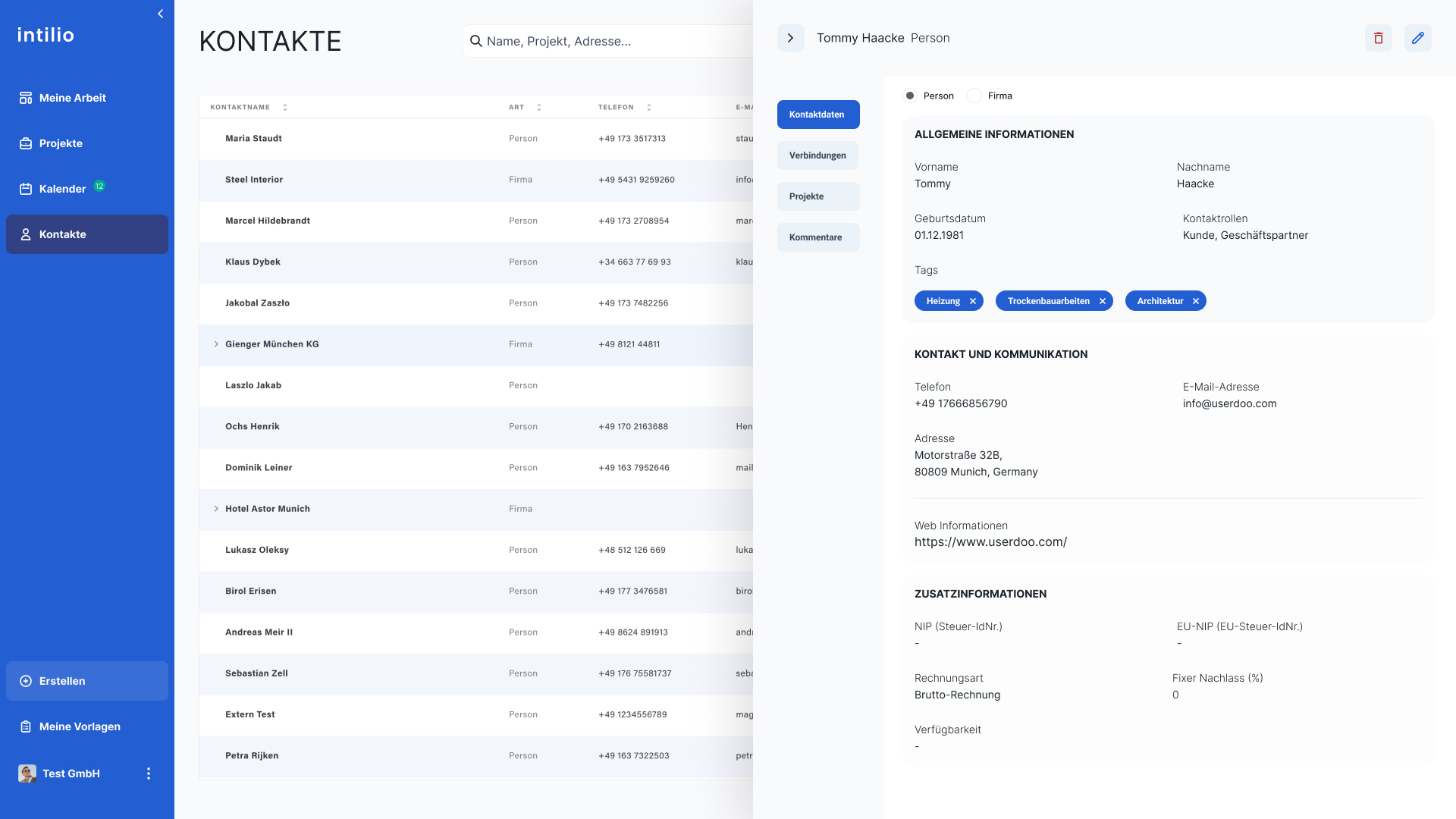Furkan Efe Dikmen
Menu
Intilio: From Internal Chaos to Commercial Success
Userdoo | Product Designer | 3+ months | Mid-project entry | Construction industry digitization
The Problem
How do you transform a chaotic, single-user internal tool into a commercially viable construction management platform while working within pre-established design constraints?
The Solution
Strategic UX improvements, modern interface patterns, and innovative timeline visualization that made complex construction project management accessible and scalable.
The Context
Intilio was developed as an internal tool for a construction company to manage their project workflows. After years of customization for a single user's specific needs, the product had evolved into a chaotic, difficult-to-use system. The company recognized an opportunity to commercialize this tool for small to medium-sized construction companies seeking digital transformation.
The Challenge
When I joined the project mid-development, several critical issues needed addressing:
User Experience Chaos:
- Years of ad-hoc customization had created inconsistent interaction patterns
- Information architecture was overwhelming and hard to navigate
- No systematic approach to complex data visualization
Commercial Viability Concerns:
- Interface wasn't suitable for diverse construction company needs
- Missing essential features expected in modern business software
- Complex workflows weren't accessible to new users
Technical Constraints:
- Had to work within pre-established design direction and style guide
- Some components were already built and couldn't be redesigned from scratch
- German documentation with limited context for feature requirements
The Opportunity
If we could streamline the user experience while maintaining the powerful functionality, we could:
- Transform a niche internal tool into a competitive commercial product
- Serve the underserved market of small-to-medium construction companies
- Modernize an industry still relying heavily on manual processes
- Create scalable design patterns that could grow with the product
Process: Strategic Design Within Constraints
Understanding the Inherited System
Initial Assessment: When I joined, I had to quickly understand:
- Existing design patterns and style guide established by my manager
- Complex user workflows specific to construction project management
- Technical limitations and development constraints
- Client priorities and commercial goals
Key Challenge: Working with incomplete German documentation and inherited components while maintaining design consistency.
Strategic Approach: High-Impact, Low-Risk Improvements
Rather than attempting wholesale redesigns, I focused on strategic improvements that would have maximum impact within existing constraints.
Solution: Four Key Design Interventions
1. Project Flow Redesign: From Overwhelming to Intuitive
The Problem: The original project tracking used segmented controls with listed cards underneath, creating cognitive overload and poor information hierarchy.
My Solution: Collapsible Tab System
- Replaced segmented controls with collapsible tabs containing project cards
- Provided more heuristic, familiar interaction patterns
- Reduced visual clutter while maintaining information density
- Allowed users to focus on specific project stages without distraction
Design Decisions:
- Progressive disclosure: Users see only what they need, when they need it
- Familiar patterns: Leveraged established UI conventions for easier adoption
- Scalable structure: System works with varying numbers of projects and stages
Old Design
New Design

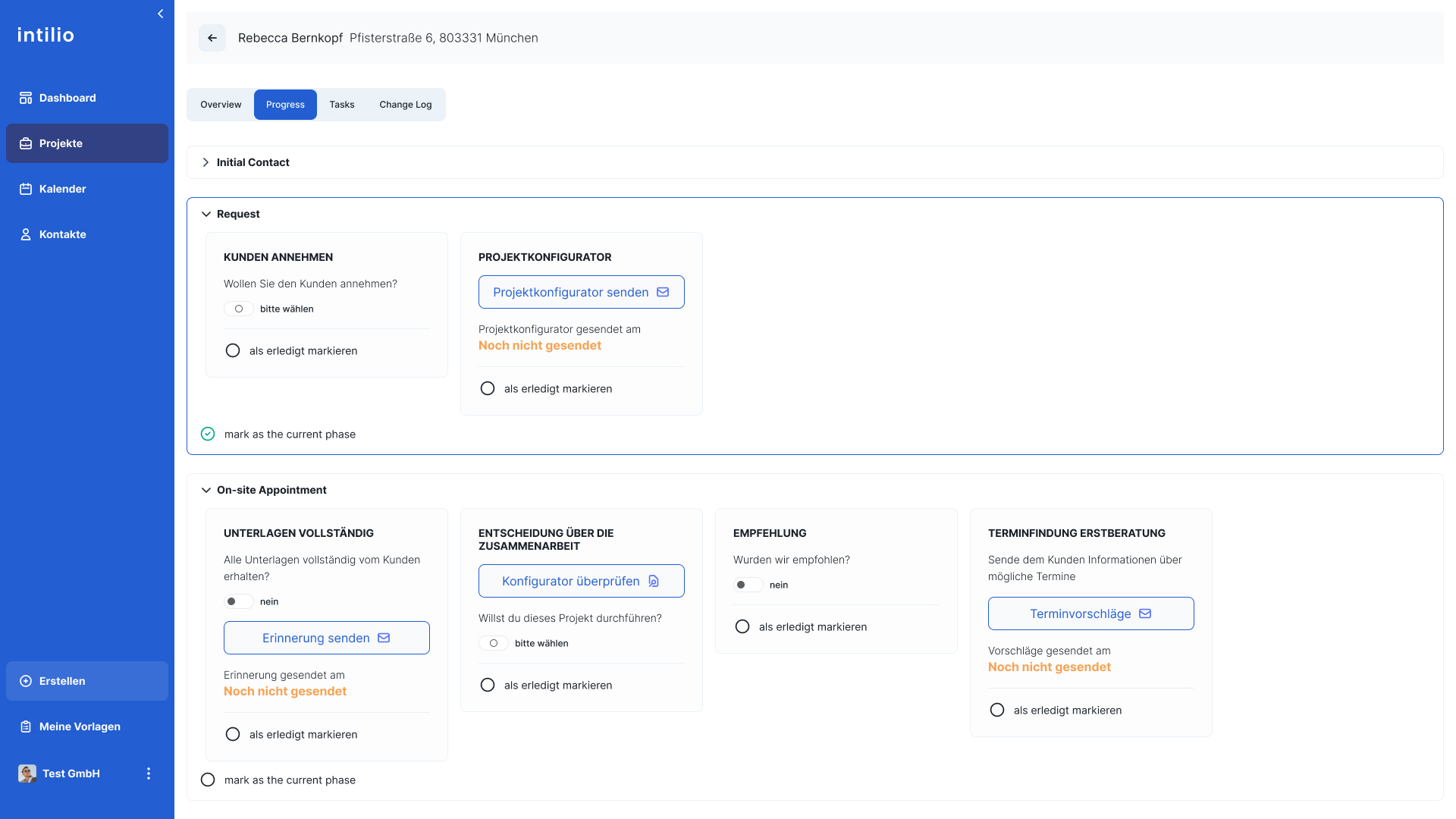
2. Contacts Module: Modernizing Data Management
The Priority Request: The client specifically requested modernizing their contacts system from traditional tables to a more contemporary interface.
My Solution: Card-Based Contact System
- Designed modern contact cards with clear visual hierarchy
- Improved information density without overwhelming users
- Created more engaging, scannable interface
- Enabled better relationship management for construction projects
Iteration Process:
- Multiple design iterations based on client feedback
- Balanced information density with visual clarity
- Ensured scalability for companies with extensive contact lists
Old Design
New Design
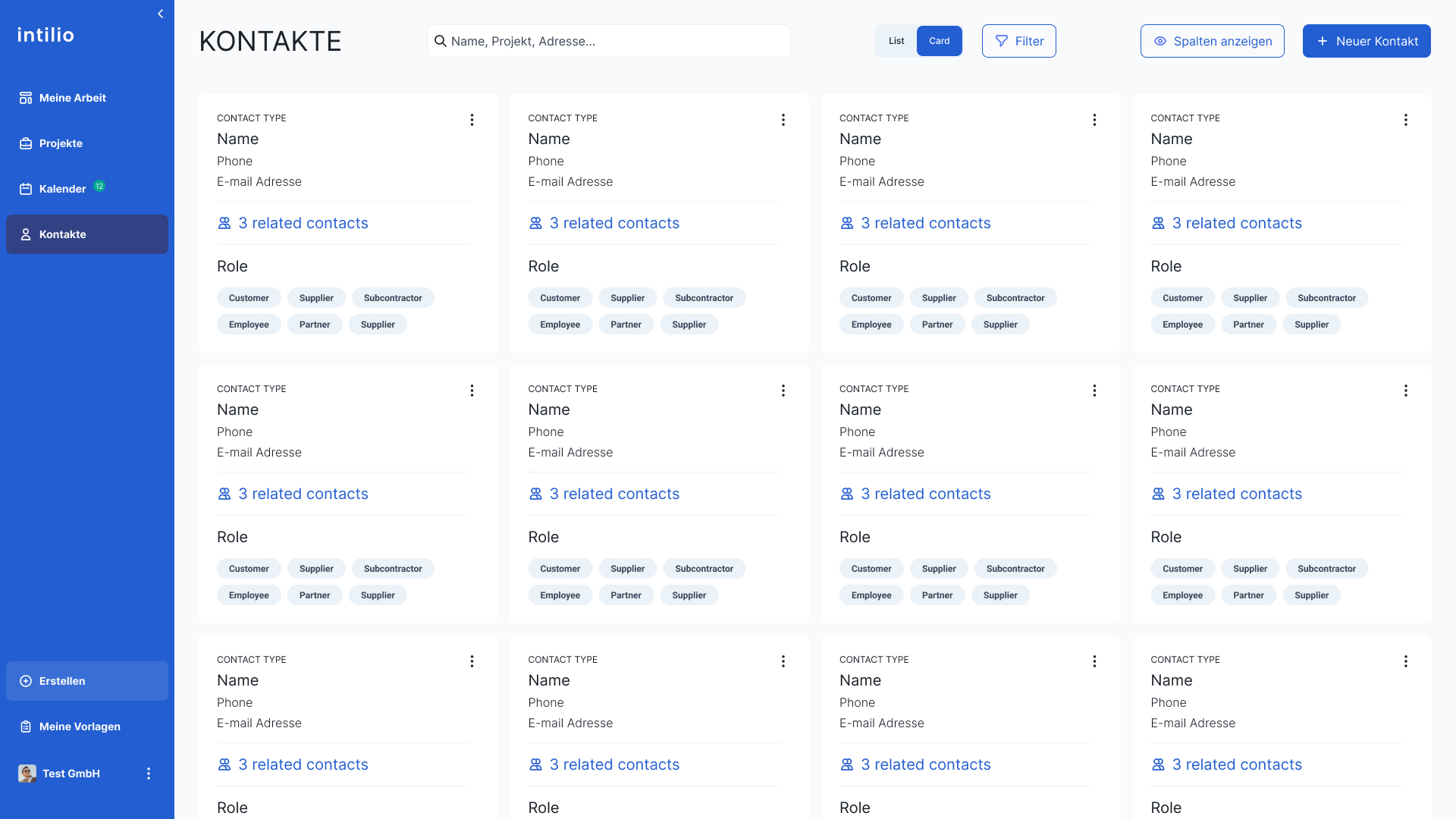

3. Comprehensive Notifications System
The Gap: The web platform had no notification system, while the poorly-designed mobile version included basic notifications.
My Process:
- Analysis: Studied mobile version to understand notification types and user needs
- Wireframing: Created low-fidelity wireframes for web notification patterns
- Design Development: Evolved wireframes into fully-designed system
- User Experience Design: Planned complete interaction flows
Final System Features:
- Read/unread state indicators for clear status communication
- Filtering capabilities by notification type and read status
- User actions: Archive, mark as read/unread functionality
- Visual hierarchy ensuring important notifications stand out

4. Advanced Timeline Visualization
The Challenge
The most complex feature I designed was the project timeline view, a way for construction managers to visualize multiple projects, their stages, and resource allocation over time.
Specific Requirements:
- Display large numbers of projects simultaneously
- Show different project states (planned, active, paused)
- Indicate resource allocation and workload intensity
- Support different time scales (daily, quarterly, yearly)
- Include construction-specific elements like scaffolding assets
My Solution: Multi-Dimensional Timeline System
Information Architecture: Four Project Categories: Negotiation, Won, In Planning, Execution
- Clear project lifecycle organization
- Easy status assessment at a glance
- Logical workflow progression
Three Display Modes:
- Monthly View: Shows individual days of the month
- Quarterly View: Displays weeks for medium-term planning
- Yearly View: Shows months for long-term strategic overview
Advanced Interaction Design:
- Zoom functionality: Users can compress or expand timeline views
- Navigation controls: Arrow buttons for temporal navigation
- Infinite scroll: Horizontal timeline navigation, vertical project scrolling
- Expandable/collapsible: Project bars can be minimized or expanded for detail
Visual Design Complexity
Project State Differentiation:
- Planned timeline: Light-colored bars for proposed schedules
- Working timeline: Saturated bars for active projects
- Paused projects: No stroke styling to indicate inactive status
- Active/live projects: Border styling for immediate identification
Workload Heat-mapping: Visual indicators showing periods of high or low activity, helping managers balance resource allocation and identify potential bottlenecks.
Construction-Specific Features: Scaffolding Asset Tracking: Unique striped bars representing scaffolding usage, critical for construction companies that rent these expensive assets externally.
Additional Timeline Features
Filtering and Display Controls:
- "Show weekends" toggle for flexible planning views
- "Show paused projects" for comprehensive project visibility
Contextual Information:
- Holiday/Special Date Chips: Small indicators on timeline showing important dates
- Hover Interactions: Expandable chips revealing detailed scheduling information
- Interactive Exploration: Users can click through to see daily project details
*While I prototyped advanced zoom and navigation interactions, full implementation and testing remained incomplete due to project timeline constraints.
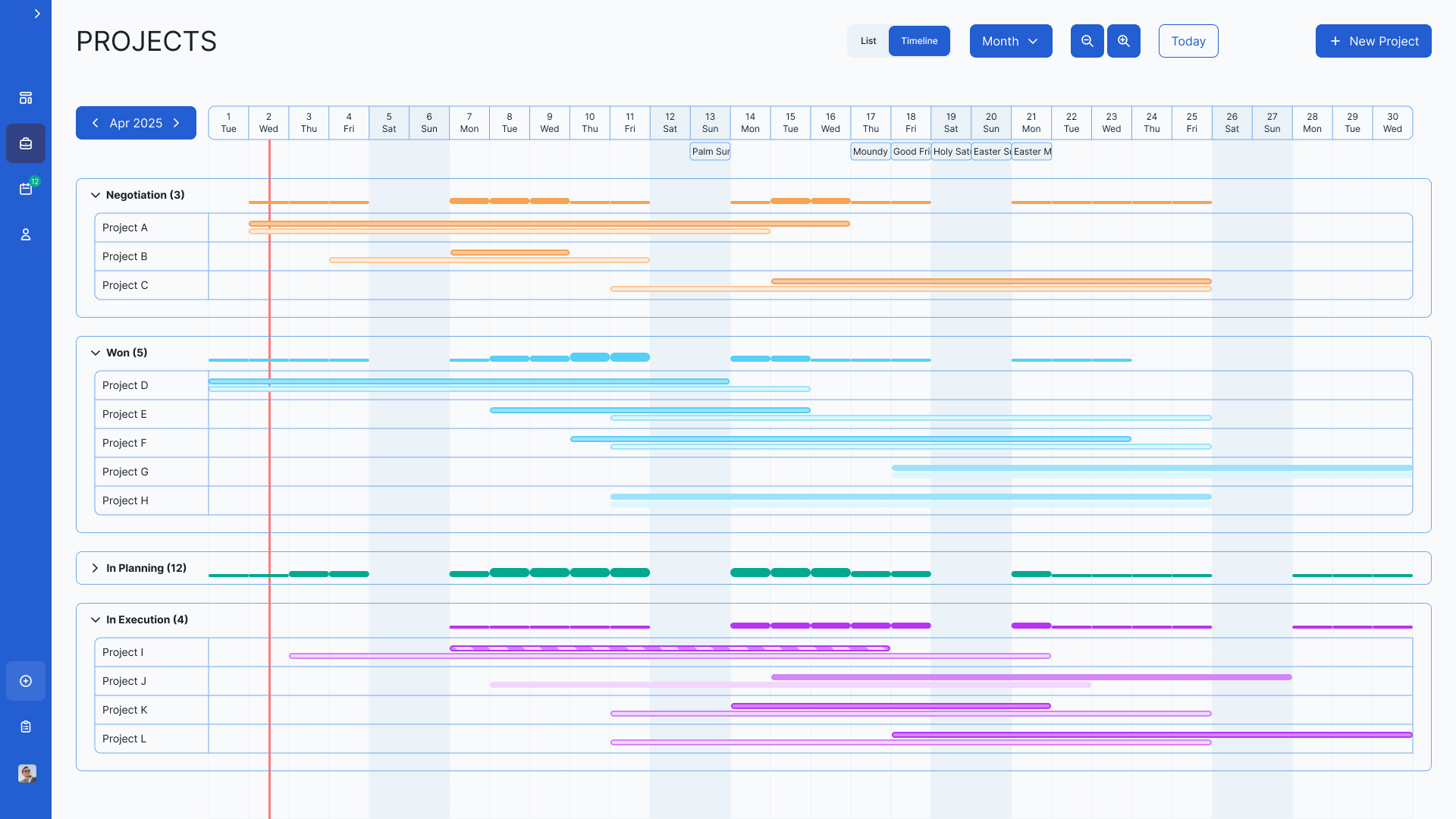

Impact: From Chaos to Commercial Viability
User Experience Improvements
- Reduced cognitive load through better information architecture
- Increased efficiency with familiar, intuitive interaction patterns
- Enhanced accessibility for construction professionals new to digital tools
- Improved information discovery through progressive disclosure and filtering
Business Impact
- Commercial readiness: Transformed internal tool into market-ready product
- Scalability: Design patterns that work for diverse construction company sizes
- Competitive advantage: Advanced timeline visualization unique in construction software market
- User adoption potential: Modern interface reducing barrier to digital transformation
Design System Contributions
- Component library expansion: Created reusable card templates and interaction patterns
- Interaction pattern establishment: Defined hover states, filtering, and navigation behaviors
- Visual hierarchy refinement: Improved information density without overwhelming users
Reflections & Learnings
Working Within Constraints
Design Leadership in Constrained Environments: Joining a project mid-development taught me to work strategically within existing design systems while still pushing for meaningful improvements. Sometimes the biggest impact comes from thoughtful refinements rather than wholesale redesigns.
Cross-Cultural Communication: Working with German documentation and translating functional requirements developed my ability to infer user needs and design intent from limited context—a crucial skill in international or legacy product work.
Complex Data Visualization
Timeline Design Complexity: The project timeline was my most complex information design challenge. Balancing multiple data dimensions (time, project state, resource allocation, project type) while maintaining usability required careful hierarchy decisions and progressive disclosure strategies.
Industry-Specific Design Thinking: Construction project management has unique requirements (like scaffolding asset tracking) that general project management tools don't address. Understanding these domain-specific needs was crucial for creating truly valuable solutions.
What I'd Do Differently
Earlier Client Engagement: I requested more detailed client input throughout the timeline design process but didn't receive sufficient feedback. In future projects, I'd establish more structured feedback loops and clearer communication protocols upfront.
Prototyping Completion: The advanced zoom and navigation interactions I designed for the timeline remained unimplemented. I'd prioritize getting at least simplified versions of innovative interactions into user testing earlier in the process.
User Research Integration: Working within existing design constraints limited my ability to conduct primary user research. I'd advocate more strongly for at least lightweight user validation of key design decisions.
Documentation and Handoff: Given the complexity of the timeline system, more comprehensive design documentation could have helped ensure full implementation of intended interactions.
The Bigger Picture: Digitizing Traditional Industries
This project reinforced my belief that thoughtful UX design can transform entire industries. Construction companies often rely on manual processes not because they prefer them, but because digital tools haven't been designed with their specific workflows and constraints in mind.
Key Lessons:
- Domain expertise matters: Understanding industry-specific needs leads to more valuable solutions
- Constraint-driven innovation: Working within limitations can spark creative solutions
- Strategic improvement over wholesale change: Sometimes evolution is more effective than revolution
- Complex data requires thoughtful hierarchy: Advanced visualization needs careful information architecture
The Intilio project showed me that even within tight constraints, strategic design thinking can transform chaotic internal tools into commercially viable products that serve real business needs.
I’m always up for meaningful design challenges, collaborations, or just a good conversation about the future of design ✦
furkanefedikmen@gmail.com
About
CV
Intilio: From Internal Chaos to Commercial Success
Userdoo | Product Designer | 3+ months | Mid-project entry | Construction industry digitization
The Problem
How do you transform a chaotic, single-user internal tool into a commercially viable construction management platform while working within pre-established design constraints?
The Solution
Strategic UX improvements, modern interface patterns, and innovative timeline visualization that made complex construction project management accessible and scalable.
The Context
Intilio was developed as an internal tool for a construction company to manage their project workflows. After years of customization for a single user's specific needs, the product had evolved into a chaotic, difficult-to-use system. The company recognized an opportunity to commercialize this tool for small to medium-sized construction companies seeking digital transformation.
The Challenge
When I joined the project mid-development, several critical issues needed addressing:
User Experience Chaos:
- Years of ad-hoc customization had created inconsistent interaction patterns
- Information architecture was overwhelming and hard to navigate
- No systematic approach to complex data visualization
Commercial Viability Concerns:
- Interface wasn't suitable for diverse construction company needs
- Missing essential features expected in modern business software
- Complex workflows weren't accessible to new users
Technical Constraints:
- Had to work within pre-established design direction and style guide
- Some components were already built and couldn't be redesigned from scratch
- German documentation with limited context for feature requirements
The Opportunity
If we could streamline the user experience while maintaining the powerful functionality, we could:
- Transform a niche internal tool into a competitive commercial product
- Serve the underserved market of small-to-medium construction companies
- Modernize an industry still relying heavily on manual processes
- Create scalable design patterns that could grow with the product
Process: Strategic Design Within Constraints
Understanding the Inherited System
Initial Assessment: When I joined, I had to quickly understand:
- Existing design patterns and style guide established by my manager
- Complex user workflows specific to construction project management
- Technical limitations and development constraints
- Client priorities and commercial goals
Key Challenge: Working with incomplete German documentation and inherited components while maintaining design consistency.
Strategic Approach: High-Impact, Low-Risk Improvements
Rather than attempting wholesale redesigns, I focused on strategic improvements that would have maximum impact within existing constraints.
Solution: Four Key Design Interventions
1. Project Flow Redesign: From Overwhelming to Intuitive
The Problem: The original project tracking used segmented controls with listed cards underneath, creating cognitive overload and poor information hierarchy.
My Solution: Collapsible Tab System
- Replaced segmented controls with collapsible tabs containing project cards
- Provided more heuristic, familiar interaction patterns
- Reduced visual clutter while maintaining information density
- Allowed users to focus on specific project stages without distraction
Design Decisions:
- Progressive disclosure: Users see only what they need, when they need it
- Familiar patterns: Leveraged established UI conventions for easier adoption
- Scalable structure: System works with varying numbers of projects and stages
Old Design
New Design


2. Contacts Module: Modernizing Data Management
The Priority Request: The client specifically requested modernizing their contacts system from traditional tables to a more contemporary interface.
My Solution: Card-Based Contact System
- Designed modern contact cards with clear visual hierarchy
- Improved information density without overwhelming users
- Created more engaging, scannable interface
- Enabled better relationship management for construction projects
Iteration Process:
- Multiple design iterations based on client feedback
- Balanced information density with visual clarity
- Ensured scalability for companies with extensive contact lists
Old Design
New Design


3. Comprehensive Notifications System
The Gap: The web platform had no notification system, while the poorly-designed mobile version included basic notifications.
My Process:
- Analysis: Studied mobile version to understand notification types and user needs
- Wireframing: Created low-fidelity wireframes for web notification patterns
- Design Development: Evolved wireframes into fully-designed system
- User Experience Design: Planned complete interaction flows
Final System Features:
- Read/unread state indicators for clear status communication
- Filtering capabilities by notification type and read status
- User actions: Archive, mark as read/unread functionality
- Visual hierarchy ensuring important notifications stand out

4. Advanced Timeline Visualization
The Challenge
The most complex feature I designed was the project timeline view, a way for construction managers to visualize multiple projects, their stages, and resource allocation over time.
Specific Requirements:
- Display large numbers of projects simultaneously
- Show different project states (planned, active, paused)
- Indicate resource allocation and workload intensity
- Support different time scales (daily, quarterly, yearly)
- Include construction-specific elements like scaffolding assets
My Solution: Multi-Dimensional Timeline System
Information Architecture: Four Project Categories: Negotiation, Won, In Planning, Execution
- Clear project lifecycle organization
- Easy status assessment at a glance
- Logical workflow progression
Three Display Modes:
- Monthly View: Shows individual days of the month
- Quarterly View: Displays weeks for medium-term planning
- Yearly View: Shows months for long-term strategic overview
Advanced Interaction Design:
- Zoom functionality: Users can compress or expand timeline views
- Navigation controls: Arrow buttons for temporal navigation
- Infinite scroll: Horizontal timeline navigation, vertical project scrolling
- Expandable/collapsible: Project bars can be minimized or expanded for detail
Visual Design Complexity
Project State Differentiation:
- Planned timeline: Light-colored bars for proposed schedules
- Working timeline: Saturated bars for active projects
- Paused projects: No stroke styling to indicate inactive status
- Active/live projects: Border styling for immediate identification
Workload Heat-mapping: Visual indicators showing periods of high or low activity, helping managers balance resource allocation and identify potential bottlenecks.
Construction-Specific Features: Scaffolding Asset Tracking: Unique striped bars representing scaffolding usage, critical for construction companies that rent these expensive assets externally.
Additional Timeline Features
Filtering and Display Controls:
- "Show weekends" toggle for flexible planning views
- "Show paused projects" for comprehensive project visibility
Contextual Information:
- Holiday/Special Date Chips: Small indicators on timeline showing important dates
- Hover Interactions: Expandable chips revealing detailed scheduling information
- Interactive Exploration: Users can click through to see daily project details
*While I prototyped advanced zoom and navigation interactions, full implementation and testing remained incomplete due to project timeline constraints.


Impact: From Chaos to Commercial Viability
User Experience Improvements
- Reduced cognitive load through better information architecture
- Increased efficiency with familiar, intuitive interaction patterns
- Enhanced accessibility for construction professionals new to digital tools
- Improved information discovery through progressive disclosure and filtering
Business Impact
- Commercial readiness: Transformed internal tool into market-ready product
- Scalability: Design patterns that work for diverse construction company sizes
- Competitive advantage: Advanced timeline visualization unique in construction software market
- User adoption potential: Modern interface reducing barrier to digital transformation
Design System Contributions
- Component library expansion: Created reusable card templates and interaction patterns
- Interaction pattern establishment: Defined hover states, filtering, and navigation behaviors
- Visual hierarchy refinement: Improved information density without overwhelming users
Reflections & Learnings
Working Within Constraints
Design Leadership in Constrained Environments: Joining a project mid-development taught me to work strategically within existing design systems while still pushing for meaningful improvements. Sometimes the biggest impact comes from thoughtful refinements rather than wholesale redesigns.
Cross-Cultural Communication: Working with German documentation and translating functional requirements developed my ability to infer user needs and design intent from limited context—a crucial skill in international or legacy product work.
Complex Data Visualization
Timeline Design Complexity: The project timeline was my most complex information design challenge. Balancing multiple data dimensions (time, project state, resource allocation, project type) while maintaining usability required careful hierarchy decisions and progressive disclosure strategies.
Industry-Specific Design Thinking: Construction project management has unique requirements (like scaffolding asset tracking) that general project management tools don't address. Understanding these domain-specific needs was crucial for creating truly valuable solutions.
What I'd Do Differently
Earlier Client Engagement: I requested more detailed client input throughout the timeline design process but didn't receive sufficient feedback. In future projects, I'd establish more structured feedback loops and clearer communication protocols upfront.
Prototyping Completion: The advanced zoom and navigation interactions I designed for the timeline remained unimplemented. I'd prioritize getting at least simplified versions of innovative interactions into user testing earlier in the process.
User Research Integration: Working within existing design constraints limited my ability to conduct primary user research. I'd advocate more strongly for at least lightweight user validation of key design decisions.
Documentation and Handoff: Given the complexity of the timeline system, more comprehensive design documentation could have helped ensure full implementation of intended interactions.
The Bigger Picture: Digitizing Traditional Industries
This project reinforced my belief that thoughtful UX design can transform entire industries. Construction companies often rely on manual processes not because they prefer them, but because digital tools haven't been designed with their specific workflows and constraints in mind.
Key Lessons:
- Domain expertise matters: Understanding industry-specific needs leads to more valuable solutions
- Constraint-driven innovation: Working within limitations can spark creative solutions
- Strategic improvement over wholesale change: Sometimes evolution is more effective than revolution
- Complex data requires thoughtful hierarchy: Advanced visualization needs careful information architecture
The Intilio project showed me that even within tight constraints, strategic design thinking can transform chaotic internal tools into commercially viable products that serve real business needs.
I’m always up for meaningful design challenges, collaborations, or just a good conversation about the future of design ✦
furkanefedikmen@gmail.com
About
CV
Intilio: From Internal Chaos to Commercial Success
Userdoo | Product Designer | 3+ months | Mid-project entry | Construction industry digitization
The Problem
How do you transform a chaotic, single-user internal tool into a commercially viable construction management platform while working within pre-established design constraints?
The Solution
Strategic UX improvements, modern interface patterns, and innovative timeline visualization that made complex construction project management accessible and scalable.
The Context
Intilio was developed as an internal tool for a construction company to manage their project workflows. After years of customization for a single user's specific needs, the product had evolved into a chaotic, difficult-to-use system. The company recognized an opportunity to commercialize this tool for small to medium-sized construction companies seeking digital transformation.
The Challenge
When I joined the project mid-development, several critical issues needed addressing:
User Experience Chaos:
- Years of ad-hoc customization had created inconsistent interaction patterns
- Information architecture was overwhelming and hard to navigate
- No systematic approach to complex data visualization
Commercial Viability Concerns:
- Interface wasn't suitable for diverse construction company needs
- Missing essential features expected in modern business software
- Complex workflows weren't accessible to new users
Technical Constraints:
- Had to work within pre-established design direction and style guide
- Some components were already built and couldn't be redesigned from scratch
- German documentation with limited context for feature requirements
The Opportunity
If we could streamline the user experience while maintaining the powerful functionality, we could:
- Transform a niche internal tool into a competitive commercial product
- Serve the underserved market of small-to-medium construction companies
- Modernize an industry still relying heavily on manual processes
- Create scalable design patterns that could grow with the product
Process: Strategic Design Within Constraints
Understanding the Inherited System
Initial Assessment: When I joined, I had to quickly understand:
- Existing design patterns and style guide established by my manager
- Complex user workflows specific to construction project management
- Technical limitations and development constraints
- Client priorities and commercial goals
Key Challenge: Working with incomplete German documentation and inherited components while maintaining design consistency.
Strategic Approach: High-Impact, Low-Risk Improvements
Rather than attempting wholesale redesigns, I focused on strategic improvements that would have maximum impact within existing constraints.
Solution: Four Key Design Interventions
1. Project Flow Redesign: From Overwhelming to Intuitive
The Problem: The original project tracking used segmented controls with listed cards underneath, creating cognitive overload and poor information hierarchy.
My Solution: Collapsible Tab System
- Replaced segmented controls with collapsible tabs containing project cards
- Provided more heuristic, familiar interaction patterns
- Reduced visual clutter while maintaining information density
- Allowed users to focus on specific project stages without distraction
Design Decisions:
- Progressive disclosure: Users see only what they need, when they need it
- Familiar patterns: Leveraged established UI conventions for easier adoption
- Scalable structure: System works with varying numbers of projects and stages
Old Design
New Design


2. Contacts Module: Modernizing Data Management
The Priority Request: The client specifically requested modernizing their contacts system from traditional tables to a more contemporary interface.
My Solution: Card-Based Contact System
- Designed modern contact cards with clear visual hierarchy
- Improved information density without overwhelming users
- Created more engaging, scannable interface
- Enabled better relationship management for construction projects
Iteration Process:
- Multiple design iterations based on client feedback
- Balanced information density with visual clarity
- Ensured scalability for companies with extensive contact lists
Old Design
New Design


3. Comprehensive Notifications System
The Gap: The web platform had no notification system, while the poorly-designed mobile version included basic notifications.
My Process:
- Analysis: Studied mobile version to understand notification types and user needs
- Wireframing: Created low-fidelity wireframes for web notification patterns
- Design Development: Evolved wireframes into fully-designed system
- User Experience Design: Planned complete interaction flows
Final System Features:
- Read/unread state indicators for clear status communication
- Filtering capabilities by notification type and read status
- User actions: Archive, mark as read/unread functionality
- Visual hierarchy ensuring important notifications stand out

4. Advanced Timeline Visualization
The Challenge
The most complex feature I designed was the project timeline view, a way for construction managers to visualize multiple projects, their stages, and resource allocation over time.
Specific Requirements:
- Display large numbers of projects simultaneously
- Show different project states (planned, active, paused)
- Indicate resource allocation and workload intensity
- Support different time scales (daily, quarterly, yearly)
- Include construction-specific elements like scaffolding assets
My Solution: Multi-Dimensional Timeline System
Information Architecture: Four Project Categories: Negotiation, Won, In Planning, Execution
- Clear project lifecycle organization
- Easy status assessment at a glance
- Logical workflow progression
Three Display Modes:
- Monthly View: Shows individual days of the month
- Quarterly View: Displays weeks for medium-term planning
- Yearly View: Shows months for long-term strategic overview
Advanced Interaction Design:
- Zoom functionality: Users can compress or expand timeline views
- Navigation controls: Arrow buttons for temporal navigation
- Infinite scroll: Horizontal timeline navigation, vertical project scrolling
- Expandable/collapsible: Project bars can be minimized or expanded for detail
Visual Design Complexity
Project State Differentiation:
- Planned timeline: Light-colored bars for proposed schedules
- Working timeline: Saturated bars for active projects
- Paused projects: No stroke styling to indicate inactive status
- Active/live projects: Border styling for immediate identification
Workload Heat-mapping: Visual indicators showing periods of high or low activity, helping managers balance resource allocation and identify potential bottlenecks.
Construction-Specific Features: Scaffolding Asset Tracking: Unique striped bars representing scaffolding usage, critical for construction companies that rent these expensive assets externally.
Additional Timeline Features
Filtering and Display Controls:
- "Show weekends" toggle for flexible planning views
- "Show paused projects" for comprehensive project visibility
Contextual Information:
- Holiday/Special Date Chips: Small indicators on timeline showing important dates
- Hover Interactions: Expandable chips revealing detailed scheduling information
- Interactive Exploration: Users can click through to see daily project details
*While I prototyped advanced zoom and navigation interactions, full implementation and testing remained incomplete due to project timeline constraints.


Impact: From Chaos to Commercial Viability
User Experience Improvements
- Reduced cognitive load through better information architecture
- Increased efficiency with familiar, intuitive interaction patterns
- Enhanced accessibility for construction professionals new to digital tools
- Improved information discovery through progressive disclosure and filtering
Business Impact
- Commercial readiness: Transformed internal tool into market-ready product
- Scalability: Design patterns that work for diverse construction company sizes
- Competitive advantage: Advanced timeline visualization unique in construction software market
- User adoption potential: Modern interface reducing barrier to digital transformation
Design System Contributions
- Component library expansion: Created reusable card templates and interaction patterns
- Interaction pattern establishment: Defined hover states, filtering, and navigation behaviors
- Visual hierarchy refinement: Improved information density without overwhelming users
Reflections & Learnings
Working Within Constraints
Design Leadership in Constrained Environments: Joining a project mid-development taught me to work strategically within existing design systems while still pushing for meaningful improvements. Sometimes the biggest impact comes from thoughtful refinements rather than wholesale redesigns.
Cross-Cultural Communication: Working with German documentation and translating functional requirements developed my ability to infer user needs and design intent from limited context—a crucial skill in international or legacy product work.
Complex Data Visualization
Timeline Design Complexity: The project timeline was my most complex information design challenge. Balancing multiple data dimensions (time, project state, resource allocation, project type) while maintaining usability required careful hierarchy decisions and progressive disclosure strategies.
Industry-Specific Design Thinking: Construction project management has unique requirements (like scaffolding asset tracking) that general project management tools don't address. Understanding these domain-specific needs was crucial for creating truly valuable solutions.
What I'd Do Differently
Earlier Client Engagement: I requested more detailed client input throughout the timeline design process but didn't receive sufficient feedback. In future projects, I'd establish more structured feedback loops and clearer communication protocols upfront.
Prototyping Completion: The advanced zoom and navigation interactions I designed for the timeline remained unimplemented. I'd prioritize getting at least simplified versions of innovative interactions into user testing earlier in the process.
User Research Integration: Working within existing design constraints limited my ability to conduct primary user research. I'd advocate more strongly for at least lightweight user validation of key design decisions.
Documentation and Handoff: Given the complexity of the timeline system, more comprehensive design documentation could have helped ensure full implementation of intended interactions.
The Bigger Picture: Digitizing Traditional Industries
This project reinforced my belief that thoughtful UX design can transform entire industries. Construction companies often rely on manual processes not because they prefer them, but because digital tools haven't been designed with their specific workflows and constraints in mind.
Key Lessons:
- Domain expertise matters: Understanding industry-specific needs leads to more valuable solutions
- Constraint-driven innovation: Working within limitations can spark creative solutions
- Strategic improvement over wholesale change: Sometimes evolution is more effective than revolution
- Complex data requires thoughtful hierarchy: Advanced visualization needs careful information architecture
The Intilio project showed me that even within tight constraints, strategic design thinking can transform chaotic internal tools into commercially viable products that serve real business needs.
I’m always up for meaningful design challenges, collaborations, or just a good conversation about the future of design ✦
furkanefedikmen@gmail.com
